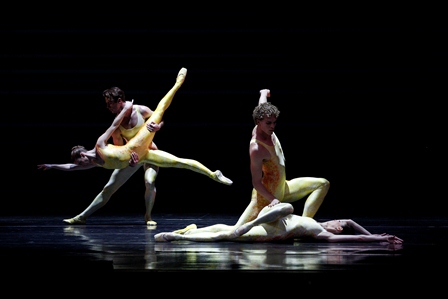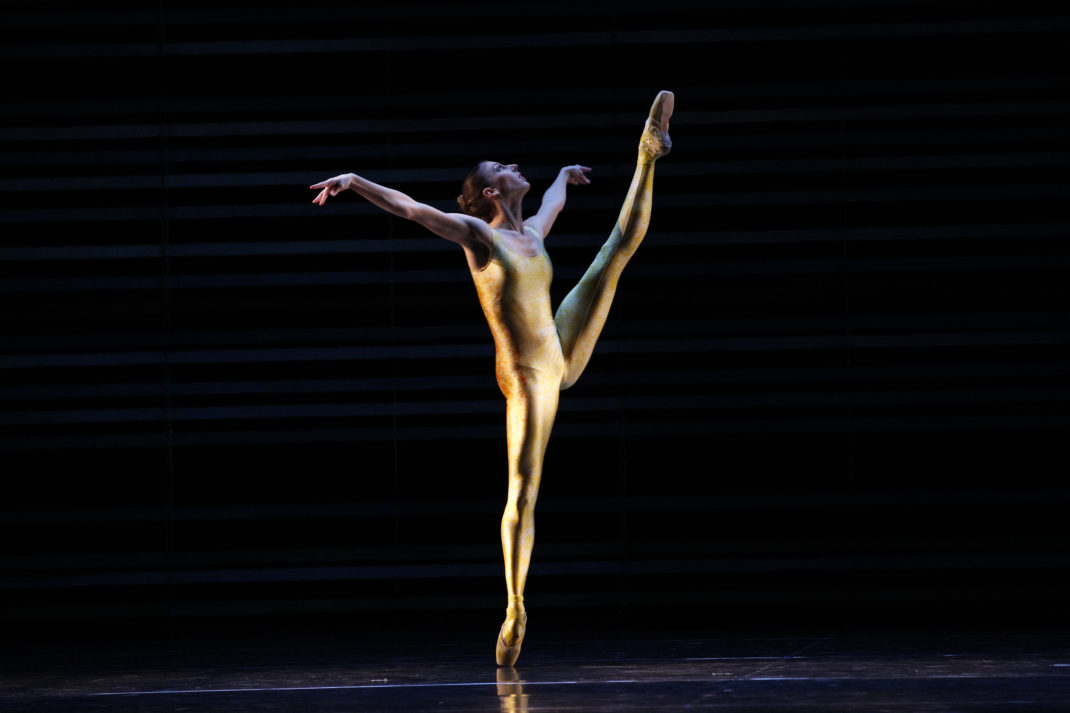30 August 2012, State Theatre, Victorian Arts Centre, Melbourne
The Australian Ballet’s Icons program is a truly exciting triple bill. Every work has particular interest historically and, while one really doesn’t measure up, two of the three are thrilling to watch. The absolute standout in terms of dancing is the middle work on the program, Gemini, Glen Tetley’s work made on the Australian Ballet in 1973. It was danced on opening night by Lana Jones, Amber Scott, Adam Bull and Rudy Hawkes, with Jones in particular performing as if there were no tomorrow.

Against a modernist set of coloured horizontal slats by Nadine Baylis, Gemini unfolds as a series duets and solos embodying powerful, dynamic movement. Of the women, Jones is cool but bold, assertive, a powerhouse of energy. Her manège of grands jetés with arms stretched heavenwards in an open fifth position (à la Isadora in La Marseillaise) was breathtaking. Scott is more elusive, sinuous and deliciously sensuous. Of the men, Bull had that little extra movement in the chest and pelvis—in the torso I guess—that drew the eye towards him whenever the men were onstage. Hawkes’ performance lacked the same zing but was nevertheless a pleasure to watch. When Tetley was in Australia in 2003 to stage Voluntaries he told me that creating Gemini had made him love the energy of Australian dancers. I think he would have been thrilled with the electrifying way in which Jones, Scott, Bull and Hawkes performed.
Closing the evening was Graeme Murphy’s evocative Beyond Twelve, a work first shown in 1980 and a real bottler of an Australian ballet showing all Murphy’s theatricality, humour and unique choreographic hand. Beyond Twelve tells the story of a boy’s transition from football-playing youth to adolescent dancer and finally on to mature artist facing the uncertainties of life beyond dance. Brett Chynoweth, Calvin Hannaford and Andrew Killian took the three main male roles of Beyond Twelve, Beyond Eighteen and Beyond Thirty and their trio in which we see their lives intertwining was a real highlight. Showing the passage of time in a choreographic sense is one of Murphy’s great strengths and this trio is no exception. Brooke Lockett, a coryphée with the company, danced the role of First Love and played it with just the right feeling of delight in the pleasures of youth.
Beyond Twelve is an immensely moving work (as well as being full of wit and humour) and nothing captures that feeling more than when, as the ballet closes, we see the mature dancer joined momentarily by his first love. And just as it looks like they will remain together, a figure in evening dress appears in the background and the girl moves away to join the other man, her Escort. Murphy’s sense of theatricality is brilliant here, partly in his placement of the three characters on the stage, but also in the instant realisation the moment generates that life is full of changes.
Despite its historical interest, the big disappointment of the evening was The Display, Robert Helpmann’s 1964 production based on his and Katharine Hepburn’s sighting of the mating dance of the lyrebird. The Display opened the program and perhaps it was inevitable that a work so entrenched in Australian culture of the 1960s would never translate well into the twenty-first century. But I didn’t think it would be quite so problematic. Nothing to me looked like an Australian picnic in the bush. The girls, so pretty with their Renoir hairstyles and pink dresses, could have been peasants in Giselle—and incidentally, Sidney Nolan, whose designs were ‘refurbished’ for the occasion, wanted the girls’ dresses to be the colour of ‘dog biscuits’, which certainly wasn’t the case with this production. In addition, the boys looked like princes as they pointed their feet, stretched their legs, and stayed so thoroughly within their classical ballet heritage. I’m not sure that, when playing footy, drinking beer and punching people up, men look like that.
Kevin Jackson as the Outsider missed the point, I think, that this character was meant to be so culturally different from the rest of the men. A red shirt and blue trousers aren’t enough to show that he was meant to be an Italian in Australia in the 1960s, a time of significant European migration. Australians had scarcely heard of coffee then let alone of European attitudes to women. The role needs a different physicality as well as costume to get the point across and Jackson didn’t seem to me to be much different from the rest of the men. But then perhaps that was a result of the other men behaving as if they were dancing a nineteenth-century ballet.
The saving grace was Madeleine Eastoe as the Female. She made Helpmann’s choreography look quite respectable despite a series of fouettés that Helpmann suddenly dropped into it all for no apparent reason. And she managed to get across the sense of sexual arousal that needs to be apparent as, at the conclusion of the ballet, the Outsider leaves her after his attempted rape and the Male (the lyrebird) comes forward to cover her with his tail feathers.
It was interesting to see Barry Kitcher, Bryan Lawrence and Garth Welch from the 1964 cast of Display come onstage to take a bow during the curtain calls. They were joined by Julie da Costa who danced the Female in a later 1980s production. There was no note in the program to say that they had been involved in coaching the dancers. The Display certainly needed some good coaching to make it work.
Musically the program was extraordinarily diverse. Malcolm Williamson’s score for The Display remains as beautiful as ever with its quivering, bush sounds, and was perhaps the highlight of that ballet on this occasion; Tetley’s choice of Hans Werne Henze’s Symphony No. 3 for Gemini was inspired with music and choreography so well attuned; and Maurice Ravel’s Piano Concerto in G major, whose movements had been reordered by Murphy to fit the storyline of Beyond Twelve, was played with customary elegance by Stuart Macklin.
Despite The Display having major problems, I thought this was a good triple bill. In my mind it sits within the spirit of the best of triple bills where there is a bit of everything, including the ‘serious’ work in the middle and the ‘feel good’ work to go home with.
Michelle Potter, 1 September 2012
Featured image: Lana Jones in Gemini. The Australian Ballet, 2012. Photo: © Jeff Busby

Postscript: Looking back at a review of Beyond Twelve that I wrote for Dance Australia way back in 1994 (with David McAllister, Steven Woodgate, Greg Horsman and Vicki Attard in the leading roles), I mentioned that Horsman danced the role of Beyond Twenty-Five, rather than calling it Beyond Thirty. I’m not sure when the name change happened, but it is interesting to speculate that times have changed in (almost) twenty years and perhaps thirty is now the new twenty-five? Unless I got it wrong in 1994?
Update: Here are my comments after another look at the program in Sydney.

Michelle, you have it exactly right. Just home from Icons and searching the web for reviews so that I can see whether anyone else found The Display as excruciating as I did. Even the dancers looked embarrassed to be presenting second rate choreography in ludicrous costumes to tell a story that is dated at best – I would describe it as unimaginative, misogynistic, crass and contrived. Not how we want the world to characterize dance in Australia – by contrast Beyond 12 was absolutely Australian dance at its best – understated, physically and emotionally challenging – and with just that little twist of ironic humour that brings us back down to earth.
Oh – and Gemini was sublime.
Thanks for your comment Alison. I have continued to ponder and ponder and still think that Display didn’t have to look as bad as it did. Coaching and more coaching was missing I think. Having said that the theatricality that characterises Murphy’s works is so very different from that of Helpmann. Helpmann was certainly not understated, which is a lovely way to describe what Murphy gave us in Beyond Twelve! A beautiful and moving work was the result. And I guess we are lucky that Murphy (and Janet Vernon of course) are still available to add their final touches to the work before it goes onstage.